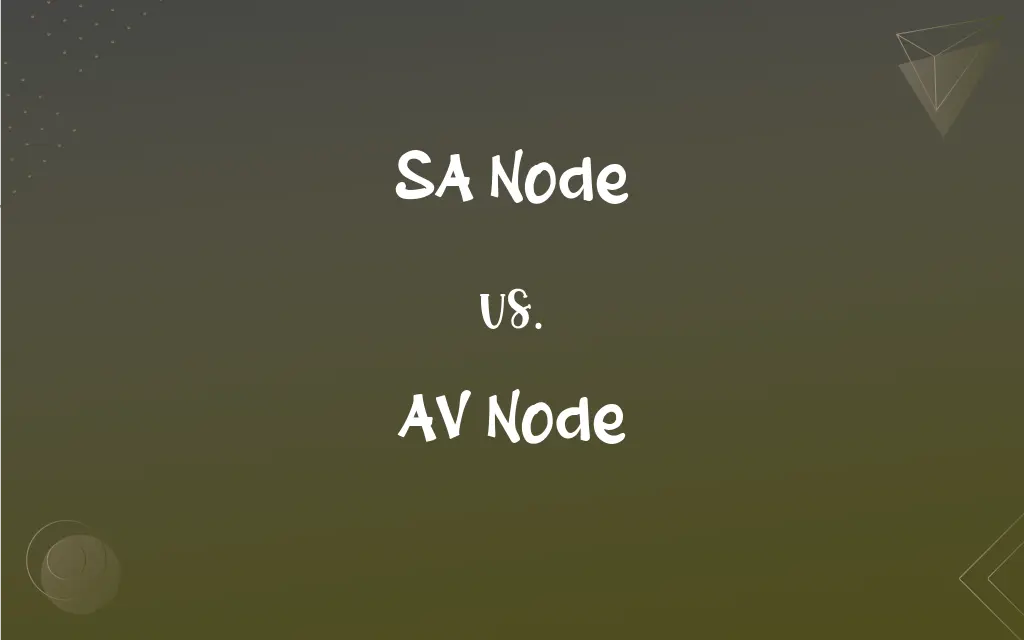SA Node vs. AV Node: What's the Difference?
Edited by Janet White || By Harlon Moss || Updated on July 11, 2024
The SA node initiates the heartbeat, setting its pace, while the AV node, located in the middle of the heart, delays electrical impulses, allowing ventricles to fill with blood before they contract.

Key Differences
The SA node, or sinoatrial node, acts as the heart's natural pacemaker, generating electrical impulses that initiate each heartbeat. Conversely, the AV node, which stands for atrioventricular node, is responsible for temporarily delaying the electrical impulse, ensuring that the ventricles have adequate time to fill with blood before contracting. Both nodes play crucial roles in maintaining a coherent and efficient cardiac rhythm, albeit with distinctly different functions.
The SA node is strategically located in the right atrium of the heart. It releases an electrical impulse that triggers the atria to contract, pushing blood into the ventricles. The AV node, positioned at the junction of the atria and ventricles, serves as a crucial bridge for the electrical impulse, moderating its journey from the atria to the ventricles. These nodes together facilitate the orderly propagation and management of electrical signals through cardiac tissue, sequentially coordinating contractions.
Electrical impulses originating from the SA node, disseminate through the atria, leading them to contract and push blood into the ventricles. As the impulse reaches the AV node, it encounters a brief delay, which is imperative to permit the ventricles to receive the blood and be primed for the subsequent contraction. Therefore, the sequential actions of the SA node and AV node ensure that the phases of the cardiac cycle are appropriately synchronized.
The SA node is fundamental in establishing the rate and rhythm of the heartbeat, typically instigating 60 to 100 impulses per minute under resting conditions. In contrast, the AV node, while not initiating impulses, critically influences the heart's rhythm by inserting a deliberate pause between atrial and ventricular contractions, thereby ensuring efficient blood flow from the atria to the ventricles. This orchestrated collaboration stabilizes and organizes cardiac functionality.
A dysfunction in the SA node can result in arrhythmias, as the heart may beat too fast, too slow, or with an irregular rhythm. On the other hand, if the AV node malfunctions or the pathway between the atria and ventricles is disrupted, it might impede the systematic progression of electrical impulses through the heart, also potentially resulting in arrhythmias. Both nodes are integral to maintaining a steady, rhythmic heartbeat, thus safeguarding optimal cardiac performance.
ADVERTISEMENT
Comparison Chart
Primary Function
Initiates the heartbeat and sets its pace
Delays the impulse, aiding ventricular filling
Location
Located in the right atrium
Positioned at the atria-ventricle junction
Impulse Generation
Generates electrical impulses autonomously
Does not generate, but conducts impulses
Influence on Rhythm
Directly determines the heart’s rhythm
Modulates the rhythm via impulse delay
Association with
Associated with tachycardia when overactive
Associated with heart block when dysfunctional
ADVERTISEMENT
SA Node and AV Node Definitions
SA Node
Positioned in the right atrium, it regulates the heart rate and rhythm.
An erratic SA node can result in an irregular heart rhythm, disrupting optimal blood flow.
AV Node
The AV node can conduct impulses even if the SA node fails.
In some cases, the AV node compensates for SA node issues by conducting impulses to the ventricles.
SA Node
It autonomously generates impulses, normally 60-100 times per minute at rest.
A well-functioning SA node helps maintain a balanced and efficient heartbeat, especially during physical activity.
AV Node
It is integral in preventing excessively rapid ventricular contractions.
The AV node moderates the electrical impulses, shielding the ventricles from overly rapid stimulation.
SA Node
It electrically stimulates the atria, causing them to contract.
The SA node ensures the atria contract effectively, pushing blood into the ventricles.
AV Node
The AV node introduces a delay in electrical impulse progression.
The AV node ensures that ventricles contract slightly after the atria, optimizing blood flow.
SA Node
The SA node is the heart’s primary pacemaker, initiating electrical impulses.
The SA node ensures the heart beats systematically by originating each cycle's initial impulse.
AV Node
Located between the atria and ventricles, it acts as an electrical gateway.
The AV node plays a crucial role in managing the sequenced contractions of the heart chambers.
SA Node
In response to physical or emotional stress, it can increase heart rate.
When you exercise, the SA node accelerates the heartbeat to supply muscles with more oxygenated blood.
AV Node
It crucially assists in coordinated ventricular contraction by delaying impulses.
Effective pumping of blood from the heart is facilitated by the AV node's temporal delay of electrical impulses.
FAQs
What is the primary function of the SA node?
The SA node initiates electrical impulses, acting as the heart's natural pacemaker.
Can the heart function if the SA node fails?
Yes, secondary pacemakers like the AV node can manage the heart's rhythm, albeit usually at a slower rate.
What occurs when the AV node malfunctions?
A malfunctioning AV node can disrupt the systematic flow of electrical impulses, potentially causing arrhythmias.
What happens to heartbeats when the SA node is overactive?
An overactive SA node can lead to tachycardia, resulting in a faster-than-normal heart rate.
Where is the SA node located?
The SA node is located in the right atrium of the heart.
What is the role of the AV node in heart functionality?
The AV node delays electrical impulses, ensuring ventricles fill with blood before contracting.
How does aging affect the SA node?
Aging can cause fibrosis or wearing out of the SA node, potentially impacting its function and the heart's rhythm.
Can interventions like pacemakers bypass SA node and AV node issues?
Yes, artificial pacemakers can manage the heart’s rhythm, effectively bypassing SA and AV node dysfunctions when needed.
Is the AV node capable of initiating a heartbeat?
While it doesn’t initiate heartbeats, the AV node can generate impulses if the SA node fails, though typically at a slower pace.
Are SA node dysfunctions hereditary?
While some cardiac conditions are hereditary, SA node dysfunction can be influenced by various factors, not solely genetics.
How does the SA node respond to stress?
The SA node can increase the heart rate in response to stress to meet the body's increased demand for oxygen.
Can the AV node be the source of arrhythmias?
Yes, if the AV node conducts impulses irregularly, it can result in certain types of arrhythmias.
Is AV node dysfunction always symptomatic?
Not necessarily. AV node dysfunction may not always present noticeable symptoms and might be identified during routine checks.
Can abnormalities in the SA node lead to atrial fibrillation?
Yes, irregularities in SA node function can contribute to arrhythmias like atrial fibrillation.
What happens when the AV node allows too rapid conduction?
Excessively rapid conduction through the AV node may result in inefficient ventricular contractions and compromised cardiac output.
Can the AV node be treated or altered medically?
Yes, certain interventions like ablation can modify AV node function to manage specific cardiac conditions.
How does the SA node influence athletic performance?
The SA node regulates heart rate and rhythm, affecting oxygen supply during physical activity, thus impacting athletic performance.
Why is the delay caused by the AV node crucial for heart functionality?
The AV node's delay ensures synchronized contractions between the atria and ventricles, promoting efficient blood pumping.
Is the AV node essential for survival?
While crucial for normal heart rhythm, individuals can survive with an impaired AV node using artificial pacemakers.
What impact do stimulants have on the SA node?
Stimulants, like caffeine, can influence the SA node, potentially increasing heart rate and altering rhythm.
About Author
Written by
Harlon MossHarlon is a seasoned quality moderator and accomplished content writer for Difference Wiki. An alumnus of the prestigious University of California, he earned his degree in Computer Science. Leveraging his academic background, Harlon brings a meticulous and informed perspective to his work, ensuring content accuracy and excellence.
Edited by
Janet WhiteJanet White has been an esteemed writer and blogger for Difference Wiki. Holding a Master's degree in Science and Medical Journalism from the prestigious Boston University, she has consistently demonstrated her expertise and passion for her field. When she's not immersed in her work, Janet relishes her time exercising, delving into a good book, and cherishing moments with friends and family.
































































